 The Jančys family brewhouse The Jančys family brewhouse |
Keptinis is a little-known Lithuanian style of beer where the mash is baked in an oven. The first farmhouse brewer I ever wrote about was keptinis brewer Ramunas Čižas. A few years ago I put together a description of how to brew keptinis based on ethnographic sources. Martin Warren followed my instructions, but ended up with just black, unfermentable water. So when Simonas invited me to come to Lithuania to see keptinis being brewed, he didn’t need to ask twice.
The Jančys family lives in nearby Utena, but often visits their farm in Vikonys, in north-eastern Lithuania, where they come from. And they still brew keptinis in the old way. The brewhouse is a small brick building on the farm, where Vytautas Jančys, who owns the farm, has built a brick oven specifically so he can brew keptinis. The art of brewing keptinis is something he learned from his father and grandfather, so he’s a real farmhouse brewer. He used to also make his own malts from barley, dried on top of the oven, until about a decade ago.
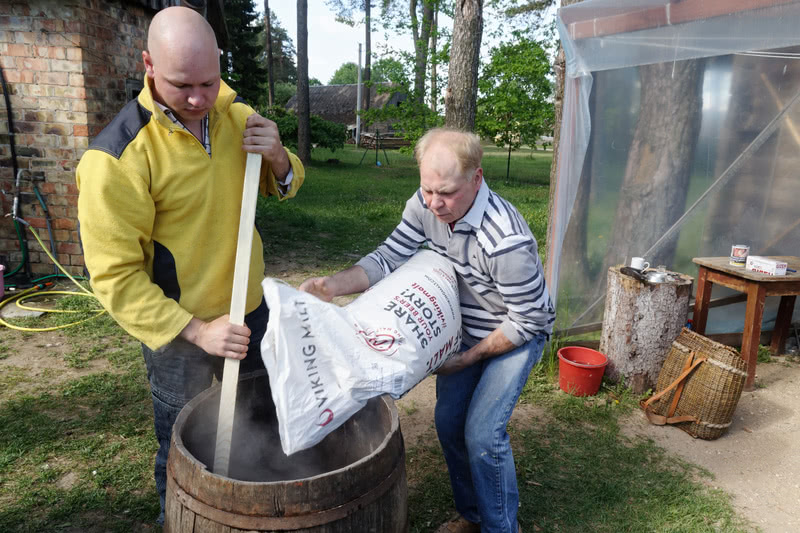 Starting the mash. Ignas on the left, Vytautas on the right Starting the mash. Ignas on the left, Vytautas on the right |
When we arrived, they had gotten the fire going, and were heating the brew liquor. Outside, in the yard, they’d set up the mashtun, and were getting ready to start mashing.
Vytautas poured a sack of pale malts from Viking Malts in Panevežys into the tun, then added buckets of boiling hot water while his son Ignas stirred the mash. They were using water, not juniper infusion, because this was Lithuania, not Norway. Vytautas kept adding water, and eventually started lifting the mash paddle, staring intently at the drops running off it. Then he would add some more water, then repeat. Finally, he was satisfied. Now they could pack up the mashtun and let it stand.
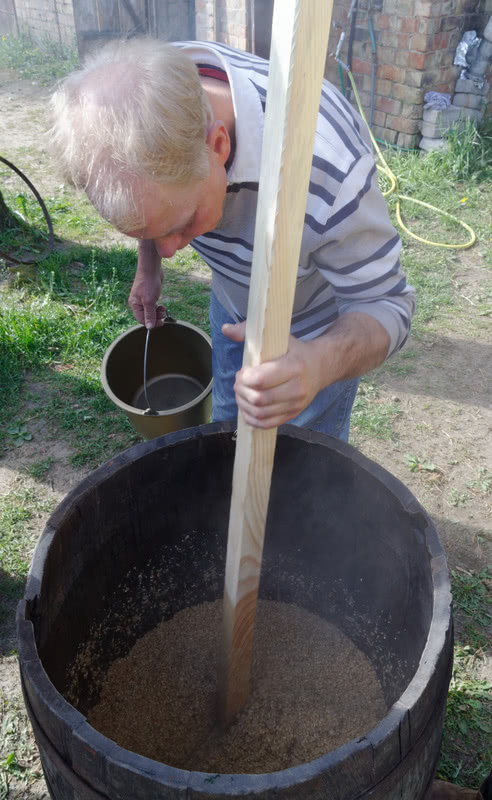 Judging the mash |
But I’d seen no thermometer, so how could he know this was the right mash temperature? I went over to check with my own thermometer. It showed 65C. Simonas saw my surprise and explained to me what was going on. Since Vytautas was using boiling water the temperature of the water was always the same. So if he could hit the right ratio of water to malts, the temperature of the mix would also be roughly right. And this is what Vytautas was doing when he was staring at the paddle: he was judging the ratio of water to malts.
Now the mash needed to rest for an hour, so there was a pause.
 The mash The mash |
Once the hour was up they started scooping the mash out of the mashtun and into metal boxes. These boxes are an innovation that Vytautas has introduced. In older descriptions and ethnographic videos the mash is formed into bread-like chunks where straw is used to help them stick together. The boxes are easier to use since they prevent the chunks from falling apart.
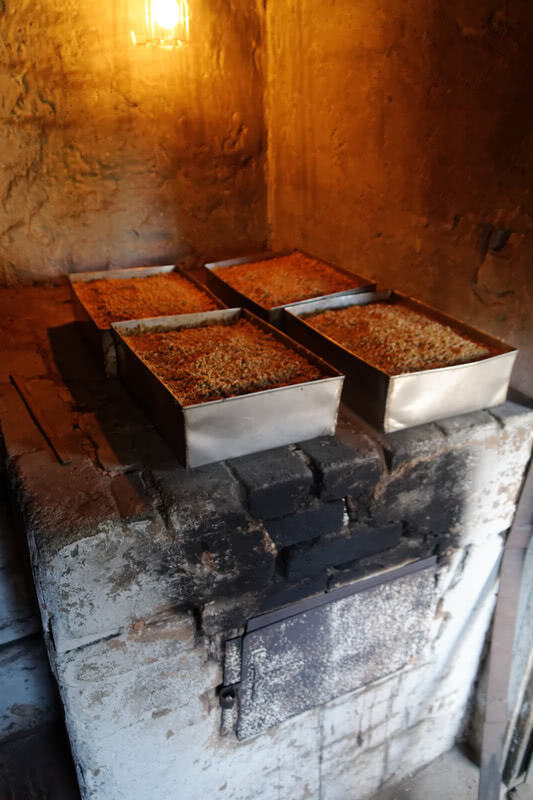 The mash boxes on top of the oven |
Vytautas carried the four boxes in and put them on top of the oven. Then he used a shovel to remove the still-glowing embers from the oven. Putting on a plexiglass mask and big gloves he then put the four boxes into the oven, where they would bake for three hours. How hot the oven was I don’t know for certain, but clearly very hot. Simonas thinks the temperature is about 350-400C. This is at the beginning, of course. The fire has been removed, so the oven will slowly cool over the course of the three hours.
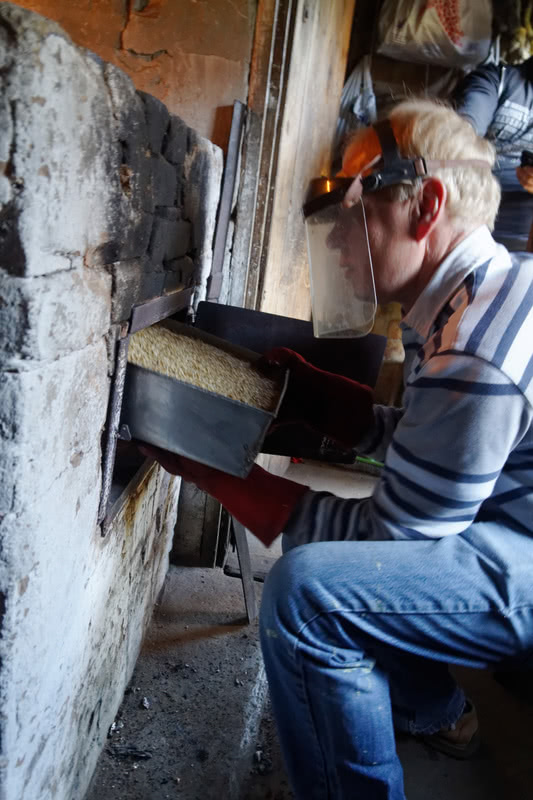 Putting the mash in the oven |
Now there was another long wait, so Vytautas took us down into his cellar, where he keeps the beer. The June sun was hot outside, but down here in the cellar it was so cool it felt cold. The beer was stored in stainless steel kegs. Traditionally, people would use wooden casks, of course, but these are much harder to work with.
And there was another reason to prefer steel.
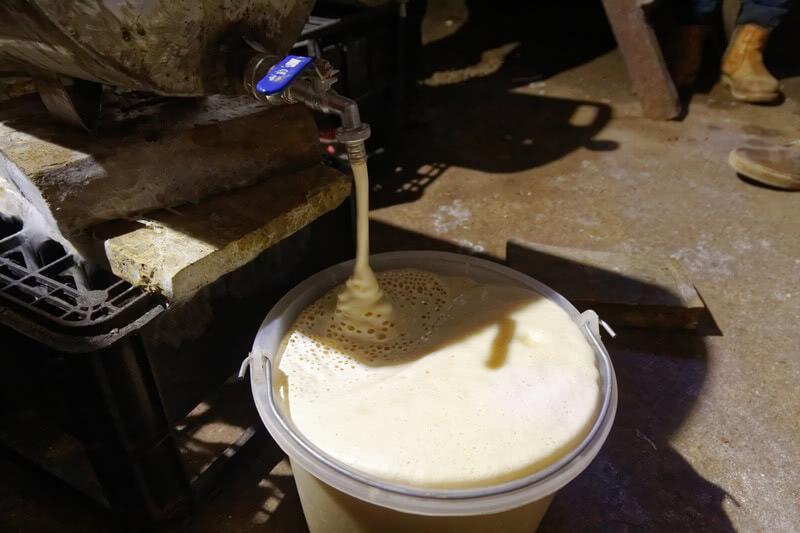 Pouring the beer Pouring the beer |
Vytautas put a plastic bucket under one keg and started to pour. Into the bucket ran what looked like porridge. The pressure in the keg was so high that what came out was pure foam, and we had to wait a good while before the foam turned into beer that we could actually drink. This is normal and traditional for Lithuanian farmhouse ale in general. Kegging the beer at the right moment to have enough CO2 in the cask, but not so early that the whole thing explodes is quite tricky, and serving the beer from wooden casks with primitive taps was also non-trivial.
The bucket was carried back up in the sunshine, poured into a ceramic mug, and served. The beer was deep dark red, nearly black, with a tiny beige head. It was quite sweet, with a massive flavour of toast, caramel, and earth. Very round and mild in the flavour, like a less roasted porter or a more toasty or caramelized brown ale. What was most impressive was the depth of the flavour, and at the same time how rounded and mellow it was. Deep notes of caramel and coffee lingered for a long time.
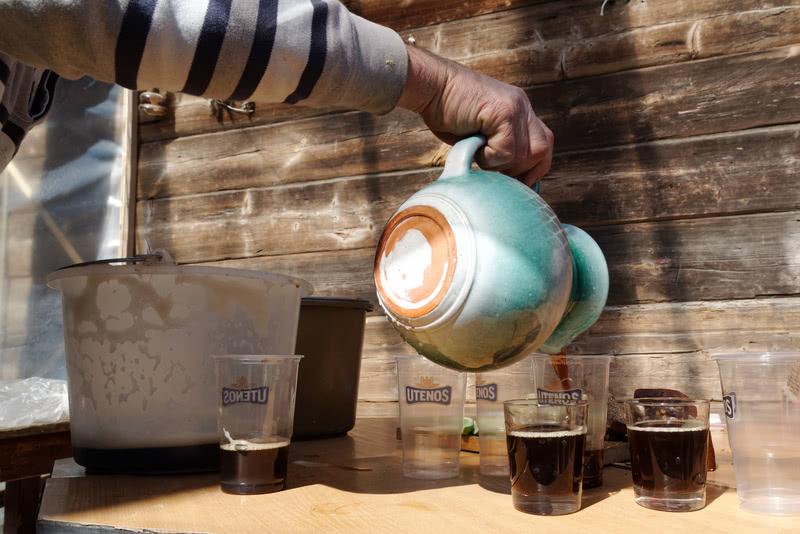 Serving the beer Serving the beer |
It was a deeply impressive beer, and although this was a year ago, I still remember that massive earthy, toasty caramel flavour quite vividly.
While the mash was still baking they started preparing for the lautering. Ignas brought out wooden spiles of alder wood, which were soaked in water so that they wouldn’t float up and ruin the filter. Vytautas took us to the barn where a huge plastic bag of straw was hanging under the ceiling, so that the mice woudldn’t get into it.
Originally, they used the classic Lithuanian wooden lauter tun with a hole in the bottom and a long rod for opening and closing the hole. However, it’s a lot of work to keep these free of leaks and completely clean, so Vytautas has had a stainless steel replacement constructed. They put the wooden spiles on the bottom, then the wheat straw on top.
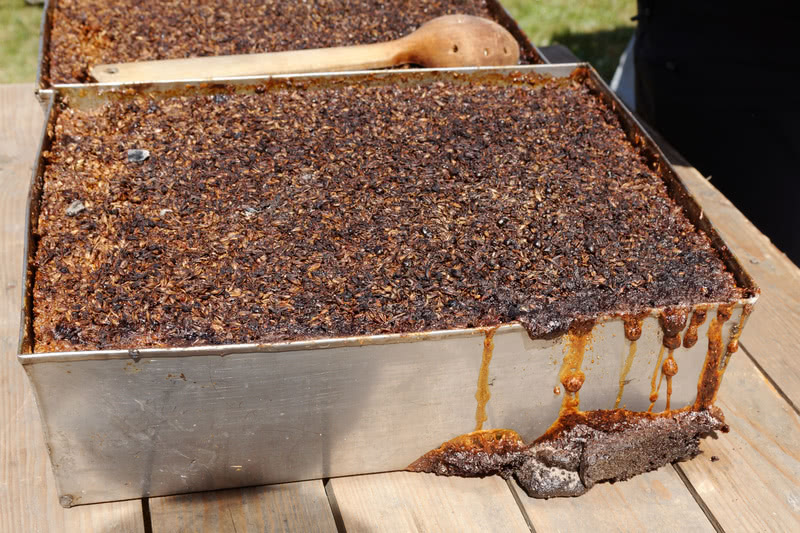 The baked mash The baked mash |
Now it was time for the mash to come out of the oven. The top of the mash was covered in a hard, dark brown crust. Some of the liquid had boiled over the side of the box, run down the side, and congealed in a hard mass at the bottom. I broke some bits off the top crust and tasted them: massively sweet and toffeeish, with notes almost like honey. They actually tasted like really sweet and good cookies.
And now I realized what was going on and why Vytautas’s beer had tasted so different. This is a dark beer made with pale malts, where the colour comes from the baking of the mash. In normal dark beers, the colour comes from drying the malts at high temperature. The heat makes the starch and protein in the malts go through maillard reactions, producing the colour and the roasty flavours. But in this beer it was the mash that had been baked. What went through the maillard reactions was mostly sugar, not starch. So of course the flavour wouldn’t be the same.
This is actually quite stunning.
Schwarzbier, porter, dunkel, stout, and all the other blackish beers are made from toasted starch, but keptinis is made from toasted sugar. It’s a different kind of dark beer. And, as the beer we’d tasted showed, one that could be really, really good. To make a proper keptinis you should really use Lithuanian malts and yeast, and not boil the wort, but the baked mash concept can be used to make many kinds of beers, not just a classic Lithuanian keptinis.
 Breaking the crust |
Once the lauter tun was prepared, Ignas took a large wooden spoon and started breaking up the crust on the boxes. Then the fairly dry mash was scooped out on top of the straw. Ignas then got hot water in plastic buckets, and poured it on top of the mash. They let it stand for about 20 minutes, then let the dark brown, blackish wort run off slowly into a porcelain bowl.
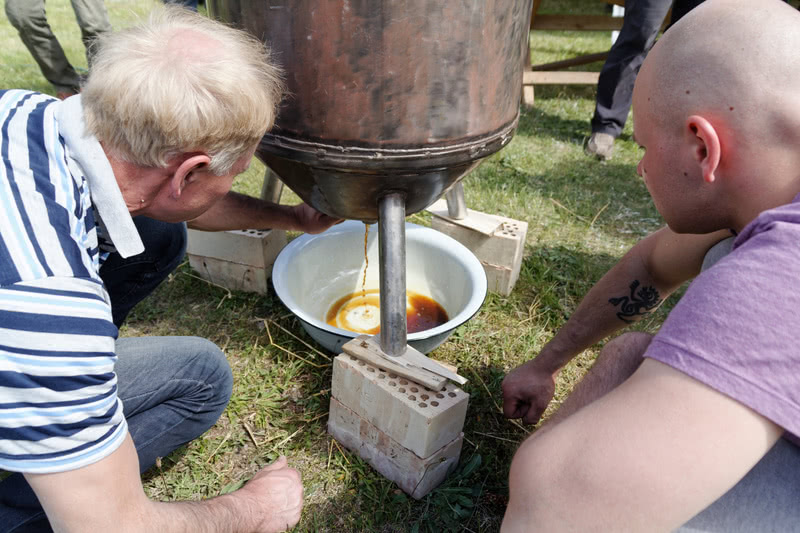 Wort coming out Wort coming out |
Meanwhile, they were boiling hop tea in a small pot. Keptinis, like all other Lithuanian farmhouse ale, is raw ale, so in order to get alpha acid out of the hops they are boiled in water. This is a simple solution that doesn’t require a big kettle and saves a lot of energy. The little pot reeked with lovely hop aroma, and after half an hour or so the hop tea (in Lithuanian, “apyny arbata”, literally hop tea), was ready. They used just bittering hops for this beer, but they told me that if you want more hop aroma you can put some of the hops in cold water to draw out the aroma.
Once the wort had been run off it was cooled with cold water from a garden hose, and poured into the fermentor. The Jančys family no longer have their own yeast, and have been using commercial yeast for the last 30 to 40 years. Before that they did have their own.
And with that they were done. Within a few days the beer would be finished fermenting, and transferred to cask.
For me this was quite an experience, to see a completely new type of brewing process. Today, keptinis is an ultra-obscure style of beer, made only by a few farmhouse brewers in north-eastern Lithuania, and by three commercial breweries. One being Ramunas Čižas, the other two being Dundulis and Kupiškio.
Of course, keptinis is not the only oven-baked style. This must have been quite close to how the Seto people used to brew. And, as it turns out, the full story is a good bit bigger than just the north-eastern corner of Lithuania. The summer of 2017, it turned out, was the summer of oven-baked beer.
We’ll dive into that story over the next few blog posts.
 The church in nearby Andrioniškis The church in nearby Andrioniškis |
Recipe
The recipe is for 130 liters of beer, which is what they usually make. 50 kilos of pale malts. Mash in at 65C, then let the temperature drop to 58C over an hour. pH at the start of mash: 6.1.
Then put the mash into an oven, where we think the initial temperature should be 400-350C. Make sure there is a good amount of water in the mash. Let the temperature drop over three hours while the mash bakes.
Take 120g bitter hops (14% alpha acid) and 50g aroma hops (5-6% alpha) and boil them for 30 minutes in 2 liters of water. There was no very clear aroma of hops in the beer, so some noble hop will probably work best.
Then lauter in the usual way, cool the wort, then pitch. They have used both modern dry yeast (probably Safale S-04, 19-25C, 2-4 days) and #16 Simonaitis (24 hours). To be honest, the yeast was not very prominent in the beer I tasted, so something fairly neutral should work. This beer isn’t really about the yeast profile, anyway.
The tricky part here is to judge when the fermentation is sufficiently done, and then transfer to closed keg where it should work up natural carbonation. If you keg too early things can blow up, and if you keg too late you’ll get flat beer.
In older times it was custom some places in Lithuania for people to ask their neighbours over to help judge if the time had come for kegging. If they decided it had come typically everyone would be served beer (kind of like oppskåke) and a party might well develop.
source: Larsblog
Keptinis: